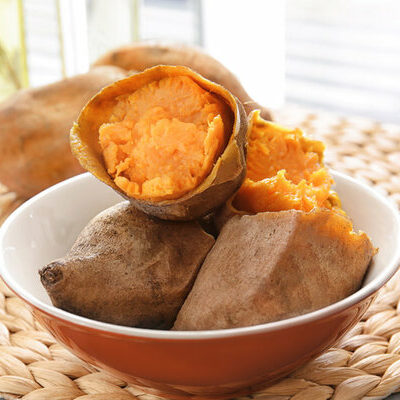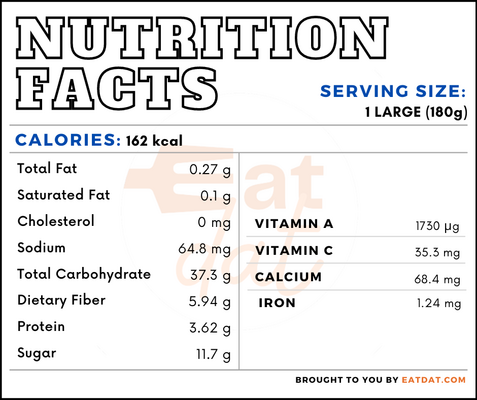
Sweet Potato
What is Sweet Potato?
Sweet potato is a root vegetable, and a member of the Convolvulaceae family of morning glory plants. It has an appearance similar to the potato, and is even distantly related to it. However, the tastes differ wildly, as this vegetable has a starchy and sweet flavor. Its name comes from these features.
- The skin color may vary depending on the variety and may be white, yellow, red, purple, orange, or even brown.
- Also, the flesh comes in a wide range of colors from white, yellow, orange, red, or any shade in between.
Some of the most popular sweet potato varieties are:
- Speckled Purple
- Heirloom
- Hannah
- Jewel
- Garnet
- Korean Purple
- Beauregard
- Creamsicle
- O’henry
- Willowleaf
- Okinawa
- Covington
- Nugget
- Amish Bush Porto Rico
- Purple
- Stokes Purple
Origin of sweet potatoes
This vegetable originated in Central America. Archeological evidence points towards their growth around 8,000 years ago. It is believed to have spread to Polynesia 900 years ago, from where it spread to neighboring regions. However, it is European colonization that spread this crop worldwide.
Nutrition
Nutritional profile for sweet potato (1 large, baked in skin):

Sweet potatoes are rich in phosphorus, potassium, vitamin A, and carotene. Also, they contain calcium, magnesium, sodium, vitamin C, folate, choline, betaine, and vitamin K.
Regular consumption of this vegetable may help in strengthening bones, muscles, and teeth, maintaining blood pressure, eye health, and the nervous system, improving metabolism, and preventing cardiovascular diseases. The high concentration of vitamin A and carotenoids in it can help in preventing skin damage, diabetes, and pancreatic cancer. Additionally, the vegetable has antioxidant, anti aging, anti-inflammatory, and antimicrobial properties.
Commercial production
The main sweet potato producing countries are China, Malawi, Nigeria, Tanzania, Uganda, Indonesia, Ethiopia, Angola, the USA, and Vietnam.
Sweet potatoes grow well in temperate climates with full sun and warm weather. They grow best in mildly acidic sandy loam soil with good drainage. The harvesting is done by digging up the tubers when the leaves start becoming yellow.
These root vegetables can be stored at room temperature in a dry and cool place away from direct sunlight. Under optimum conditions, they can last for up to 3 weeks. Once cooked, they can be kept in the refrigerator for up to 4 days.
Sweet potato recipes
These can be served with their skin intact, but they must be thoroughly washed. They can be boiled, steamed, baked, or microwaved, before being fashioned into different dishes. Frying also gives them a caramelized sweet taste. Here are a few recipes to try:
- Jian Dui
- Xi Fan
- Kolak Biji Salak
- Timus
- Kue Ubi Panggang
- Kuih Keria
- Kamote Cue
- Sakkaravalli Kizhangu Chips
- Shakarkand Curry
- Bathala Curry
- Daigaku Imo
- Goguma Mattang
- Obe Ata
- Sweet Potato Mash
- Panzanella
- Casserole
- Halwa
- Pie
- Tian
FDA regulations
The FDA classifies sweet potato under the most frequently consumed raw vegetables category. Canned sweet potato is defined as the tuber of the sweet potato plant and may be canned whole, quartered, sliced, diced, or julienned. The grades and standards for the tuber are given by the USDA.
References
Neela, Satheesh, and Solomon W Fanta. “Review on nutritional composition of orange-fleshed sweet potato and its role in management of vitamin A deficiency.” Food science & nutrition vol. 7,6 1920-1945. 17 May. 2019, doi:10.1002/fsn3.1063, https://www.ncbi.nlm.nih.gov/pmc/articles/PMC6593376/
Michaeleen Doucleff, How The Sweet Potato Crossed The Pacific Way Before The Europeans Did, The Salt: What’s on Your Plate, NPR, https://www.npr.org/sections/thesalt/2013/01/22/169980441/how-the-sweet-potato-crossed-the-pacific-before-columbus
Wang, Sunan et al. “Chemical constituents and health effects of sweet potato.” Food research international (Ottawa, Ont.) vol. 89,Pt 1 (2016): 90-116. doi:10.1016/j.foodres.2016.08.032, https://pubmed.ncbi.nlm.nih.gov/28460992
Sweet Potatoes, The Nutrition Source, Harvard T.H. Chan School of Public Health, https://www.hsph.harvard.edu/nutritionsource/food-features/sweet-potatoes/
